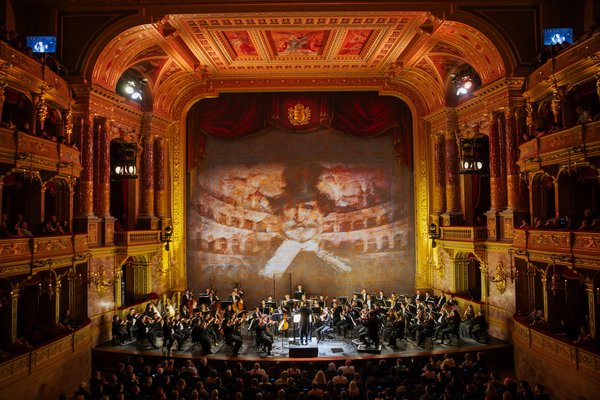
CARMINA BURANA
8 May 2024, 7 p.m.
In Brief
Scenic cantata in the original languages, with Hungarian, English, and same-language subtitles
O Fortuna. Everyone knows the overwhelmingly powerful opening motifs of Carl Orff's most famous work. What fewer people know is that Carmina Burana was not intended to be an oratorical work, but was instead expressly meant for the stage. This becomes clear from the piece's (originally Latin) subtitle: “Secular songs for singers and chorus to be sung together with instruments and magical images.”
Over the course of the many times he has conducted the work, Tibor Bogányi gradually developed a vision for a staged version. The creators conceived a breathtaking spectacle to surround the three soloists, the three dancers from the Hungarian National Ballet and the monumental 120-strong chorus on the stage of the Erkel Theatre, with the 3D “magical images” coming to life on six projection displays and LED walls.
We wish to inform you that we occasionally use light effects that may be disturbing or excessively bright for some members of the audience.
This production is presented courtesy of Schott Music GmbH & Co.
Details
- Location
- Hungarian State Opera
- Date
- May 8, 2024
- Start time
- 7 p.m.
- End time
- 9 p.m.
Synopsis
Magical images in 3D
For 15 years, painter and organist Ágnes Zászkaliczky and conductor and cellist Tibor Bogányi have been working together on finding ways to attract a wider range of audience segments to classical concerts by enhancing their productions with singular visual experiences: Zászkaliczky selects projected material from paintings created expressly for the given musical piece. Their largest-scale effort to date is the super-production Carmina Burana, which they put together with the world-renowned Budapest-based Freelusion Studio.
“We worked out the basic concept of Carmina Burana together with librettist Attila Könnyű. Not long after the idea was conceived, we found the Freelusion team, whose unique technical and artistic expertise allowed us to raise the concept of “visual concerts” to a new level. Through this collaboration, we developed real-time three-dimensional visual material that is in perfect harmony with the music. The essence of the concept is the fact that it is not the visuals that dictate the tempo, but rather the music: it is not the conductor’s task to “accompany” an existing film or animation, like at so many concerts of film music, for example. Instead, the music takes centre stage, and everything else adapts to it. We therefore had to create a form of animation that would be suitable for following the music live during the concert.
In the music, Orff followed and expressed the messages of the songs with extraordinary sensitivity. Starting from Orff’s own concept, we have selected “magical images” that reinforce the effect of the music without suppressing it, and which make the text more profound without illustrating it. The dynamic of the moods of the projection is organised along the lines of the major movements. We’ve built upon ancient symbols that can be found both in Hungarian and universal motif systems. Tímea Papp, Freelusion’s superb choreographer, we decided which movements would also incorporate dance to be performed by the outstanding dancers from the Hungarian National Ballet. We hope this will transport the audience to a magical virtual reality through Orff’s elemental music and the unique visual experience.”
Tibor Bogányi and Ágnes Zászkaliczky
Gallery
Reviews
“The production of Carmina Burana being staged in Budapest is an experience of a lifetime.”
Domokos Lajos Kabai, Bekiáltás
